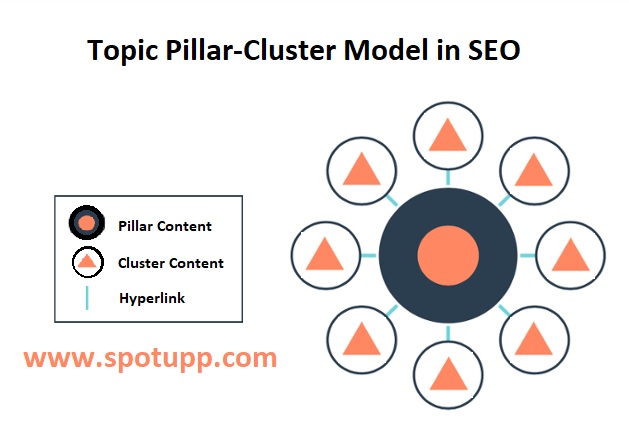The Topic Pillar-Cluster Model is an advanced content strategy designed to improve SEO by organizing content around a central “pillar” page that serves as a comprehensive guide on a broad topic. Surrounding the pillar page are “cluster” pages, which delve into specific subtopics related to the pillar. These cluster pages link back to the pillar page and, in some cases, to each other, creating a robust internal linking structure that enhances topical authority and improves search engine rankings.
Key Components:
- Pillar Page:
- A comprehensive, authoritative piece of content that provides an in-depth overview of a broad topic.
- It serves as the main hub for the topic and links out to several cluster pages.
- Cluster Pages:
- Detailed articles or pages that cover specific subtopics related to the pillar page.
- Each cluster page links back to the pillar page, reinforcing the connection and relevance.
Key Characteristics:
- Centralized Information:
- The pillar page acts as a one-stop resource, offering extensive coverage of a broad topic.
- Users can explore related subtopics in more detail through the cluster pages.
- Enhanced SEO:
- The structured internal linking between the pillar and cluster pages helps distribute link equity, boosting the SEO performance of both.
- Search engines better understand the relationship between the content, improving topical relevance and authority.
- Improved User Experience:
- Users can easily navigate between the pillar page and cluster pages, finding comprehensive and detailed information efficiently.
- This structure enhances user engagement and reduces bounce rates.
Implementing the Topic Pillar-Cluster Model:
- Identify the Pillar Topic:
- Choose a broad topic that is central to your content strategy and has substantial search volume.
- Ensure it can be broken down into several related subtopics.
- Create the Pillar Page:
- Develop a long-form, comprehensive guide that covers the pillar topic in depth.
- Ensure the content is high-quality, informative, and valuable to your audience.
- Develop Cluster Pages:
- Create detailed content pieces for each subtopic related to the pillar page.
- Each cluster page should provide in-depth information on its specific subtopic.
- Link Strategically:
- Include links from the pillar page to each cluster page, and vice versa.
- Where relevant, link cluster pages to each other to further strengthen the internal linking structure.
Example:
- Pillar Page: “Ultimate Guide to Digital Marketing”
- Cluster Page 1: “SEO Best Practices”
- Cluster Page 2: “Content Marketing Strategies”
- Cluster Page 3: “Social Media Marketing Tips”
- Cluster Page 4: “Email Marketing Techniques”
Benefits:
- Topical Authority: Establishes your site as an authoritative source on the pillar topic.
- Improved SEO: Enhances search engine understanding and indexing of your content, leading to higher rankings.
- User Engagement: Keeps users on your site longer by providing easy access to related content.
Implementing the Topic Pillar-Cluster Model can significantly enhance your website’s SEO and user experience. By creating a well-structured network of interconnected content, you not only establish your site as an authority on key topics but also make it easier for users to navigate and find valuable information. This strategic approach improves search engine understanding and indexing of your content, leading to higher rankings and increased organic traffic. Embrace the power of the Pillar-Cluster Model to elevate your content strategy and achieve sustainable growth in your online presence.
Related External Article to Read – A Simple Guide to Pillar Pages and Topic Clusters (And Why They Are The New SEO)
Enhance Your SEO with Pillar-Cluster Strategy
Ready to optimize your website’s SEO and content structure? Contact us today to implement the Topic Pillar-Cluster Model and other advanced SEO strategies. Let’s build your site’s authority and improve user engagement!


